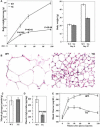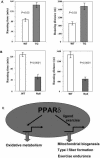Regulation of muscle fiber type and running endurance by PPARdelta
- PMID: 15328533
- PMCID: PMC509410
- DOI: 10.1371/journal.pbio.0020294
Regulation of muscle fiber type and running endurance by PPARdelta
Erratum in
- PLoS Biol. 2005 Jan;3(1):e61
Abstract
Endurance exercise training can promote an adaptive muscle fiber transformation and an increase of mitochondrial biogenesis by triggering scripted changes in gene expression. However, no transcription factor has yet been identified that can direct this process. We describe the engineering of a mouse capable of continuous running of up to twice the distance of a wild-type littermate. This was achieved by targeted expression of an activated form of peroxisome proliferator-activated receptor delta (PPARdelta) in skeletal muscle, which induces a switch to form increased numbers of type I muscle fibers. Treatment of wild-type mice with PPARdelta agonist elicits a similar type I fiber gene expression profile in muscle. Moreover, these genetically generated fibers confer resistance to obesity with improved metabolic profiles, even in the absence of exercise. These results demonstrate that complex physiologic properties such as fatigue, endurance, and running capacity can be molecularly analyzed and manipulated.
Conflict of interest statement
The authors have declared that no conflicts of interest exist.
Figures






Similar articles
-
Ginger extract prevents high-fat diet-induced obesity in mice via activation of the peroxisome proliferator-activated receptor δ pathway.J Nutr Biochem. 2015 Oct;26(10):1058-67. doi: 10.1016/j.jnutbio.2015.04.014. Epub 2015 May 28. J Nutr Biochem. 2015. PMID: 26101135
-
Standardized Kaempferia parviflora Extract Enhances Exercise Performance Through Activation of Mitochondrial Biogenesis.J Med Food. 2018 Jan;21(1):30-38. doi: 10.1089/jmf.2017.3989. Epub 2017 Nov 10. J Med Food. 2018. PMID: 29125913
-
Standardized Siegesbeckia orientalis L. Extract Increases Exercise Endurance Through Stimulation of Mitochondrial Biogenesis.J Med Food. 2019 Nov;22(11):1159-1167. doi: 10.1089/jmf.2019.4485. J Med Food. 2019. PMID: 31730422
-
Regulation of skeletal muscle physiology and metabolism by peroxisome proliferator-activated receptor delta.Pharmacol Rev. 2009 Sep;61(3):373-93. doi: 10.1124/pr.109.001560. Pharmacol Rev. 2009. PMID: 19805479 Review.
-
Roles of peroxisome proliferator-activated receptor delta (PPARdelta) in the control of fatty acid catabolism. A new target for the treatment of metabolic syndrome.Biochimie. 2004 Nov;86(11):833-7. doi: 10.1016/j.biochi.2004.09.024. Biochimie. 2004. PMID: 15589693 Review.
Cited by
-
IL-15 Mediates Mitochondrial Activity through a PPARδ-Dependent-PPARα-Independent Mechanism in Skeletal Muscle Cells.PPAR Res. 2016;2016:5465804. doi: 10.1155/2016/5465804. Epub 2016 Sep 21. PPAR Res. 2016. PMID: 27738421 Free PMC article.
-
The Nuclear Receptor, Nor-1, Induces the Physiological Responses Associated With Exercise.Mol Endocrinol. 2016 Jun;30(6):660-76. doi: 10.1210/me.2015-1300. Epub 2016 May 4. Mol Endocrinol. 2016. PMID: 27144290 Free PMC article.
-
Regulation of PPARγ Coactivator-1α Function and Expression in Muscle: Effect of Exercise.PPAR Res. 2010;2010:937123. doi: 10.1155/2010/937123. Epub 2010 Aug 19. PPAR Res. 2010. PMID: 20847946 Free PMC article.
-
Insulin resistance and altered systemic glucose metabolism in mice lacking Nur77.Diabetes. 2009 Dec;58(12):2788-96. doi: 10.2337/db09-0763. Epub 2009 Sep 9. Diabetes. 2009. PMID: 19741162 Free PMC article.
-
Daily running enhances molecular and physiological circadian rhythms in skeletal muscle.Mol Metab. 2022 Jul;61:101504. doi: 10.1016/j.molmet.2022.101504. Epub 2022 Apr 22. Mol Metab. 2022. PMID: 35470095 Free PMC article.
References
-
- Abou MJ, Yakubu F, Lin D, Peters JC, Atkinson JB, et al. Skeletal muscle composition in dietary obesity-susceptible and dietary obesity-resistant rats. Am J Physiol. 1992;262:R684–R688. - PubMed
-
- Berchtold MW, Brinkmeier H, Muntener M. Calcium ion in skeletal muscle: Its crucial role for muscle function, plasticity, and disease. Physiol Rev. 2000;80:1215–1265. - PubMed
-
- Booth FW, Thomason DB. Molecular and cellular adaptation of muscle in response to exercise: Perspectives of various models. Physiol Rev. 1991;71:541–585. - PubMed
-
- Brennan KJ, Hardeman EC. Quantitative analysis of the human alpha-skeletal actin gene in transgenic mice. J Biol Chem. 1993;268:719–725. - PubMed
Publication types
MeSH terms
Substances
LinkOut - more resources
Full Text Sources
Other Literature Sources
Molecular Biology Databases

